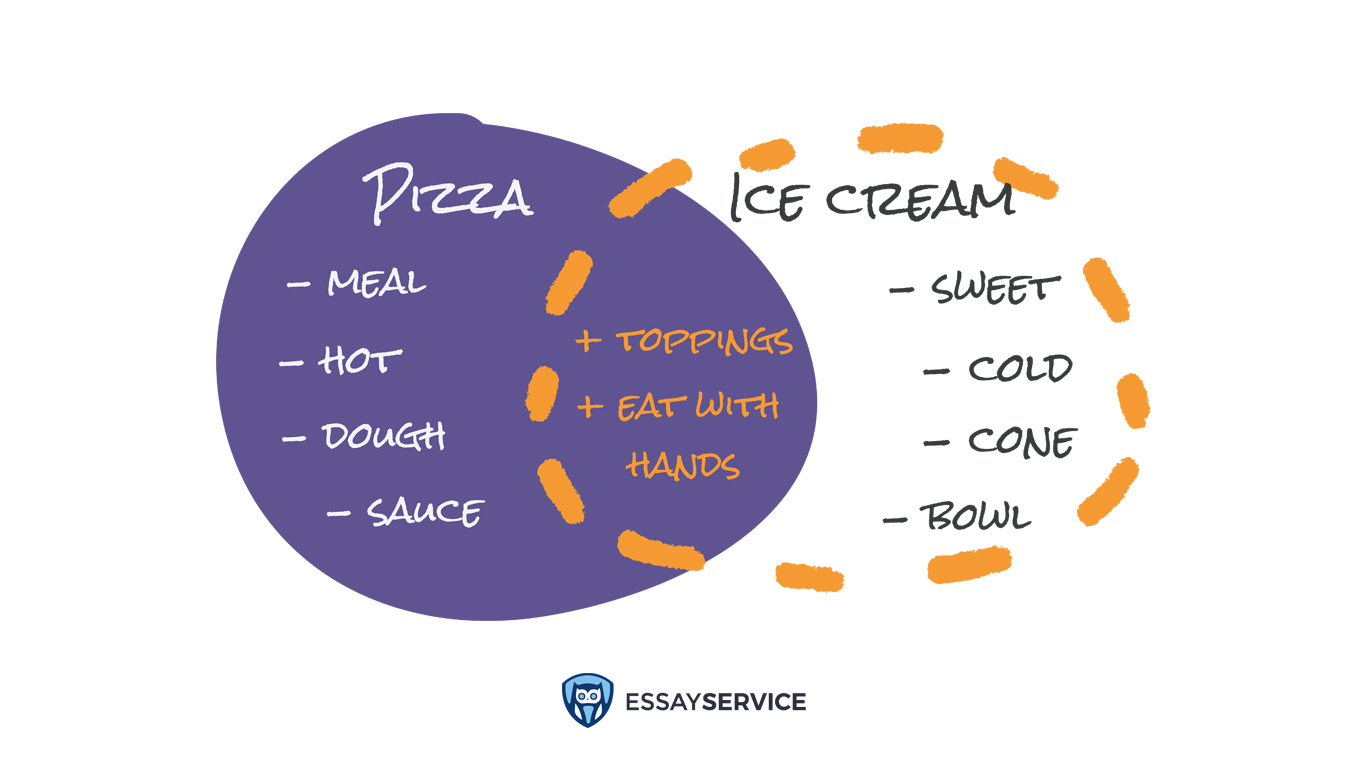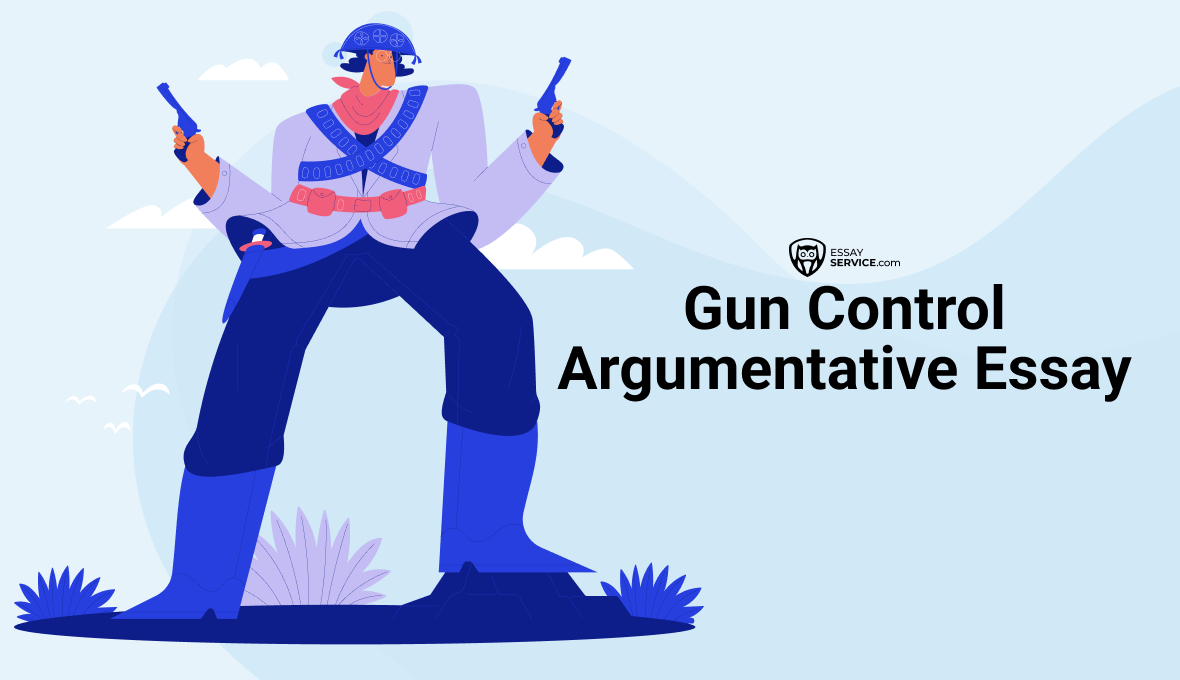
The Ultimate Guide on Compare and Contrast Essay: Topics, Outline, Example
Learning how to write a compare and contrast essay is a rite of passage for many college students, as this essay type is one of the most common assignments in college, especially in the first year. Writing a compare and contrast essay helps students develop and improve upon skills such as critical reasoning, scientific argumentation, and organized systematic writing. The best essays of this type have a clear purpose, such as shedding light on a complex idea or clearing up misconceptions about a difficult topic. Another purpose might be illustrating how one subject is better than another or perhaps highlighting a new approach to thinking about something. The individual assignment will vary, of course, and each should come with its rubric. Pay close attention to the rubric, since it will outline what your teacher is looking for, and make sure you understand the assignment before you begin. If you have a question about the essay assignment, do not hesitate to ask your teacher for help or consider the "pay for essay" services if you need further assistance.
What Is a Compare and Contrast Essay?
The compare and contrast essay format is similar to that of other essay types. The writer must state a thesis in the introduction, argue the thesis in the body, and then form a conclusion. However, with a compare and contrast essay, the goal is to show how one subject is similar to another (i.e., compare them), as well as how it is different (i.e., contrast them). Such an essay requires upfront planning to ensure the writer has a firm grasp on both subjects. One way to plan for a compare and contrast essay is to create a Venn diagram to show how two subjects are similar and different, such as this one. Here’s an example:

You may find that you need to create several of these diagrams before you know what your thesis is and what your two subjects are. Be open to different possibilities. The first two subjects you diagram may not be the ones you want to compare and contrast in your essay, but creating that diagram may give you some useful ideas.
Compare and Contrast Essay Outline
According to our write an essay for me service professionals, it would also be a good idea to create an outline before you begin writing. The outline is like a template that you can follow to keep your essay on track throughout the writing process, and it should include the introduction, body paragraphs, and conclusion.
Introduction
The standard compare and contrast essay format implies that the author should start a paper with a concise, to-the-point, and clear introduction. The good news is that the opening paragraph in this type of essay is not much different compared to other papers. It is a clause that introduces and outlines the general topic of the paper.
When writing a comparing and contrasting essay intro, you need to ensure it has the following elements:
- A hook and explanation of the general topic - The first sentence of your essay should be a hook that grabs attention and encourages readers to continue reading. Then follow general details related to the topic.
- Subjects of comparison - Next in your compare and contrast essay introduction, you should mention the specific subjects that will be compared and contrasted in the paper.
- Thesis - Finally, the opening paragraph should close with a clear and concise thesis statement.
Body Paragraphs
Once you have dealt with the introduction, it’s natural to wonder how to write a body paragraph for a compare and contrast essay.
Let’s start with the length. The number of body paragraphs can vary depending on the general word limit and the number of criteria against which you will compare contrast your subjects. But, as a rule, there should be at least 2-3 paragraphs. Every paragraph should wrap around one specific criterion (either a difference or similarity) of the comparison.
As for the contents, each paragraph must have:
- Topic sentence;
- Details collected in the course of research;
- Substantial data, evidence, stats, etc. to support the claim;
- Transition to the next part.
Pro tip: Feel free to use connector phrases (e.g., both, likewise, compared to, in contrast, unlike, etc.) and words in your comparison to give your paper a logical flow and ensure the cohesion of all your points.
Conclusion
When you have your intro and body ready, you can move on to shaping your compare and contrast essay conclusion. As a rule, this is the simplest part to write. A conclusion in compare and contrast essay should wrap up everything discussed throughout the paper and give it a sense of completion.
Here are the main points on how to write a conclusion for a compare and contrast essay:
- Provide a summary of the key ideas/points - Start by recapping the main ideas from your body paragraphs, but keep it very concise and straight to the point.
- Give a general evaluation - Shortly analyze the outcomes of your comparison and give it a final evaluation (e.g., finalize whether the subjects have more differences or similarities).
- Emphasize the significance - In the end, restate your thesis and stress the importance of the overall topic, as well as your compare and contrast points.

Compare and Contrast Essay Structure
When it comes to the question of how to structure a compare and contrast essay, there are a few strategies that students can stick to. Namely, the two methods of organizing your paper are called a Point-by-Point Method and Block Method.
Let’s take a look at each method in detail.
Point-by-Point Method
As you can easily guess, this type of structure of a compare and contrast essay implies comparing and contrasting the subjects point by point. This method works best when you are planning to compare 2 or more subjects that are more or less similar or, on the contrary, different.
To help you grasp the idea, here is how a typical body paragraph should look if you use the Point-by-Point Method:
- Topic sentence
- Subject 1
- Detail (point of comparison) 1
- Detail (point of comparison) 2
- …
- Subject 2
- Detail (point of comparison) 1
- Detail (point of comparison) 2
- …
As you can see, using this method of organization, you will be reviewing all subjects by certain points within the same body paragraph, not dividing them. The key thing to remember is that all points within one paragraph should relate to each other, and there should be one general idea per paragraph.
Block Method
Unlike the Point-by-Point Method that organizes a compare and contrast essay based on specific criteria of comparison, the Block compare and contrast essay structure implies organizing the paper based on your items. This approach will work best when the subjects of comparison are absolutely different and you have multiple criteria against which you will be contrasting them. In this case, every paragraph in the essay body will focus on a specific item.
Here is how the body of your paper should look like if you choose this comparing and contrasting essay format:
- Body paragraph 1 (Item 1)
- Criteria for contrasting 1
- Criteria for contrasting 2
- Criteria for contrasting 3
- …
- Body paragraph 2 (Item 2)
- Criteria for contrasting 1
- Criteria for contrasting 2
- Criteria for contrasting 3
- …
- Body paragraph 3 (Item 3)
- Criteria for contrasting 1
- Criteria for contrasting 2
- Criteria for contrasting 3
- …
As you can see, each body paragraph investigates a single item, spanning all the criteria that make it different from other items. If you pick this method, the main rule to stick to is to only mention one item per paragraph and always use connectors to ensure smooth transitions from one item to another.
How to Write a Compare and Contrast Essay?
End your introduction with a thesis sentence. It will allow readers to grasp your opinion of the compared subject matters, and it will logically draw their attention to the main idea.
In the thesis, provide one idea or a statement that unites both subject matters. Even if you have discovered more differences than similarities between your subject matters, you should be able to find at least one element that they have in common and include it as part of your main idea.
In the body, present as much support for your thesis as you can. Support can come in the form of statistics, research results, interviews, or other sources. Some writers prefer to mention the evidential base in the thesis, but others prefer to wait until the body of the essay.
Draw a conclusion at the end of your essay based on the similarities and differences you have presented throughout the paper. The conclusion should not introduce any new ideas but should bring closure to the paper.
Choose Your Topic
The subjects of a compare/contrast essay can vary from some physical objects to historical figures and events. The core thing to remember when choosing compare and contrast topics is that the subjects you will compare must be different. But, at the same time have some common features. For example, you may compare Democrats and Republicans, Extroverts and Introverts, etc.
Brainstorm Similarities and Differences
If you are wondering how to start a compare and contrast essay, the answer is simple - with some brainstorming. Once you define the subjects, the next thing you need to do is to brainstorm what similarities and differences they have.
To get things right, look at your two subjects separately and analyze them. Then, make two lists, one for similar points and the other one for differences, where you will be writing down all points that come into your mind.
Pro tip: If you are wondering how to compare and contrast your subjects, making lists is definitely helpful. But, if you are more of a visual person, you may find it more convenient to map out your ideas using a Venn diagram, where you’ll have two overlapping circles, one for each of your subjects, with similarities written where the circles overlap and differences written on the other sides of circles.
Write An Introduction
To start a compare and contrast essay, you will need to write a solid introduction that transitions into a clear and specific thesis sentence. The introductory paragraph should outline the topic you want to cover and provide insight into your main idea. It should mention what matters—the people, ideas, events, or other subjects you are going to compare and contrast in the body of your essay.
In the introduction, include the necessary background information. Your introduction should be brief, but exhaustive. Before stating your thesis, you should provide a preview of your supporting arguments and positions, as your reader needs to understand why your subject matter is worth comparing and contrasting.
Pay attention to the structure of your essay, and make sure it is balanced. For instance, if the whole essay will be three pages long, you should not spend two of them on the introduction.
Develop a Thesis Statement for Your Compare and Contrast Essay
The thesis statement is one of the key elements of contrast and compare paper. Its purpose is to introduce the topic and formulate a focused argument.
To create a powerful compare and contrast thesis, replace a vague, general topic (for instance, the comparison of democracy and republic ideologies) with something more specific and detailed. For example, it may sound like, “The ideas of Republicans and Democrats vary significantly in terms of plans and policies on gun control, death penalty, and other major issues, but they do agree on certain points”.
Note how this sample compare and contrast thesis statement gives you the scope for showing both similarities and differences inherent in the ideas of these two parties. But, at the same time, the statement is not 100% concrete in terms of similar and contrasting points, so it also leaves you some space to alter your comparison.
To make your statement stronger, it is also important to answer several questions such as: “So what?” and “Why do you choose to compare these particular parties?”.
To answer these questions, be sure to add some background info concerning your topic. For example, stress that Democrats and Republicans are the two largest opposing parties.
Decide on Compare and Contrast Essay Structure
Unlike other types of essays, a comparison/contrast essay doesn’t imply using the same structure. In fact, there are a couple of ways to organize your work:
Choose any of these methods. The two things that remain unchanged are the introduction with a thesis statement and a conclusion, which have to be included regardless of the chosen structure.
Write A Body Paragraphs
Start a compare and contrast paragraph with a clear but concise topic sentence that defines one point of comparison (e.g., shape, look, etc.) against which you will compare your subjects. Then say a couple of words about each of your subjects concerning the chosen point. And, finally, highlight similarities or differences using compare and contrast words.
Use the same tactic for the following body paragraphs. Remember to focus on a single point of comparison in every paragraph to retain the integrity and logical flow of your paper and, at the same time, unfold your subjects to the fullest extent.
Write Compare and Contrast Essay Conclusion
As you saw in the example above, the conclusion of an essay should help the reader understand the writer’s point of view. In other words, the best essays have a conclusion that reminds the reader of the thesis and shows, through a summary of the paper’s findings, how the thesis is correct. The example compare and contrast essay, about energy drinks, uses the thesis that energy drinks are overused and can be seen as either mind boosters or “soft drugs”. The conclusion sums up the findings from the body of the essay and then uses those findings to provide an opinion, a direct answer to the thesis question of whether energy drinks help boost the mind or inhibit it like a drug.
Proofread
Once the final draft of your compare/contrast paper is ready, be sure to read it several times and eliminate any grammar, punctuation, and other mistakes.
To make proofreading simple, make use of these tips:
- Let it rest for a few hours or, even better, a day or two;
- Use grammar and spell-check tools;
- Ask a friend to cast a fresh pair of eyes on your paper to make sure that there is nothing you may have missed.
Compare and Contrast Essay Topics
A good compare and contrast essay topic often includes words such as “versus” (vs.) or “or”, and these words may be useful in the essay’s title as well. Below is a list of potential compare and contrast essay topics for college papers. Ten of these sample topics have “vs.” in the title, and ten have “or”, clearly indicating that the resulting essays will either compare and contrast two completely different subjects or clarify two positions on the same subject.
Here is the list of possible topics for compare and contrast essay:
- Energy Drinks: Mind Boosters or Soft Drugs
- International Monetary Fund: Economic Investments or a Debt Pit
- Abortion: Life Saver or Death Sentence
- Online Courses: Waste of Time or a Key to Better Future
- Cell Phones: Vital Gadget or a Deadly Threat
- Homeopathy: Self-Deceptiveness or Real Treatment
- GMO: Famine Problem Solution or Poison
- Online Communication: True Friendship or Illusion of Emotional Bond
- Religion: Vestige of the Past or Salvation of Nations
- Plural Marriage: Way Out of Underpopulation or Flashback to Barbarian Times
- Edward Snowden vs. Julius Caesar
- Putin vs. Obama
- Orwell vs. Huxley
- Dita Von Tease vs. Bettie Page
- Bruce Lee vs. Chuck Norris
- Arnold Schwarzenegger vs. Sylvester Stallone
- Napoleon vs. Kutuzov
- Steve Jobs vs. Bill Gates
- Nikola Tesla vs. Thomas Eddison
- Jesus vs. Thor
Compare and Contrast Essay Sample
Compare and Contrast Essay Example
This example compare and contrast essay clarifies two positions on energy drinks. Notice that it does so by comparing and contrasting energy drinks with other types of caffeinated beverages. If you need more examples, you can order essay samples from our service.
Energy Drinks: Mind Boosters or Soft Drugs
Energy drinks in aluminum cans are relatively new for humankind, but stimulating substances were used centuries before aluminum cans were invented. Today, energy drinks seem to be a panacea for students during exams, white collar employees during deadline periods, night clubbers dancing all night long, athletes heading toward a record, drivers, and basically, everyone who is dog-tired and must stay awake and work hard. You drink a can, and then you are ready to go for several hours afterward.
The producers of energy drinks say that the stimulation effect of their products is ultimately healthy, so they carry on producing new energy drinks all the time. If these drinks were so safe, why would legislators be going after them? Energy drinks: mind boosters or soft drugs? Let us get this all straightened out.
Pros:
- They enhance brain activity when needed.
- The energy-boosting effects of coffee last mere 1-2 hours, while those of energy drinks last 3-4 hours. Moreover, most of them are aerated, which makes them work faster, and coffee does not get the same treatment.
- The aluminum can allow you to consume an energy drink in almost any situation: in the car, on the dance floor, in the school library, and so on. Coffee and tea are not always so portable.
Cons:
- You should drink no more than two cans of an energy drink each day. Drinking more than that increases your risk of elevated blood pressure, high blood sugar levels, or both.
- It has been said that energy drinks fill you with energy, but that is simply not true. They work as a key to your inner energy reserves, helping you tap into your naturally stored energy. Later, you have to pay the price: insomnia, weariness, peevishness, and depression.
- The caffeine in energy drinks not only builds up an addiction if you drink more than two cans a day but also exhausts your nervous system.
What conclusion can be drawn from these pros and cons? Obviously, there is nothing healthy about energy drinks. Their contents do not differ much from everyday tea, coffee, and cocoa. Moreover, they exhaust the energy reserves of our bodies. When the stimulating effect is over in three or four hours, a person goes for another can, turning into an energy drink addict, losing the ability to restore energy in a natural way. To my mind, the cons of energy drinks outweigh the pros. My verdict is that energy drinks are mind boosters in some critical situations, but you should not drink them on a regular basis, as they can take on a drug like quality and become soft drugs.
Custom Essay Writing Service Help
Still not sure how to get started? That’s OK. EssayService can help. Buy a compare and contrast essay from us, or take advantage of our services. Whatever you need to achieve your best writing ever, you can buy it right here.
Frequently asked questions
New posts to your inbox!
Your submission has been received!



